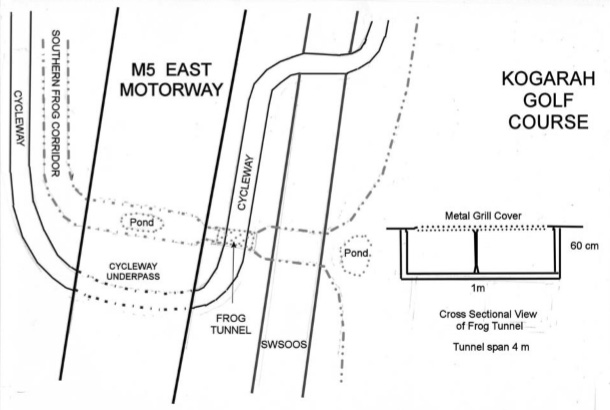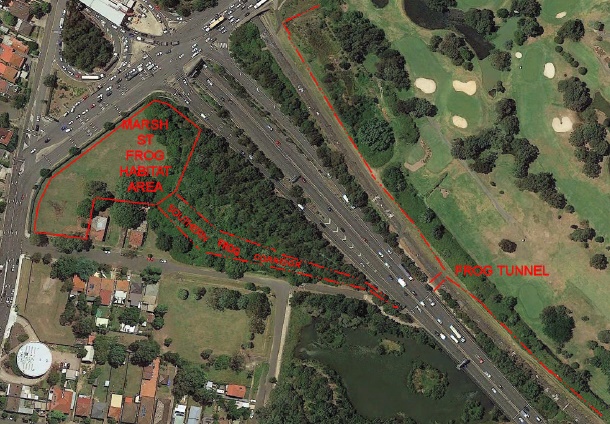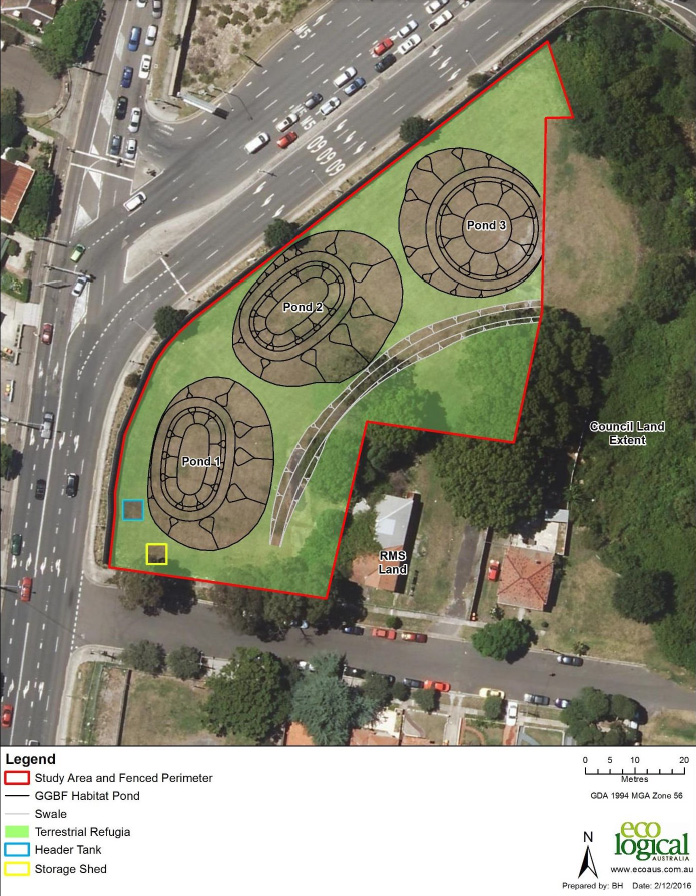
Unless otherwise indicated, the information in this section is from Eco Logical Australia 2016. Green and Golden Bell Frog Plan of Management - Arncliffe. Prepared for NSW Roads and Maritime Service (the RMS plan).
As the WestConnex work is impacting on the GGBF frog habitat, the WestConnex New M5 Instrument of Approval requires a plan to impact the offset. That plan is the Eco Logical Australia 2016. Green and Golden Bell Frog Plan of Management - Arncliffe. Prepared for NSW Roads and Maritime Service (the RMS plan). That plan prescribes that the habitat be extended to the other side of the M5 to an area between Marsh Street, Eve Street and the M5. This extension consists of two parts:


Frog tunnels are part of this design. There already are some frog tunnels which the frogs are not using (see Before WestConnex section). But the new tunnels are designed differently. Below is a description of the design from the RMS plan:
The proposed frog movement corridor from the new Frog Habitat Area at Marsh Street to the cycleway underpass, through the underpass and on to the golf course and RTA ponds involves traversing two "pinch points". The cycleway underpass is heavily used by cyclists and pedestrians and the frog crossing must be physically separated from the cycleway/pedestrian footpath.
The proposed frog corridor would parallel with the footpath (but be separated from the footpath by a frog fence) from Marsh Street to the underpass. At the underpass, the frog corridor will pass under the M5 on the western side of the oil trap pond (the footpath passes on the eastern side of this pond). Up to this point it is possible to completely isolate the frog corridor from the cycleway footpath (Figure 4).
Once the frog corridor emerges on the northern side of the underpass, it needs to cross the cycleway (and the SWSOOS) before it can continue again away from the cycleway. A low level frog underpass beneath the cycle path would need to be constructed (Figure 5). This would consist of constructing an open box culvert 2 metres wide and 60 centimetres high.
The culvert would span the cycle path and the top of the culvert would be covered with a reinforced mesh. As frogs are only likely to use this underpass at night the underpass will not need to be lit. Small open basins would be constructed on the northern side of the frog underpass and one would be constructed under the M5 East at the southern end of the underpass to encourage frog movement to the entrance and exit points of the underpass. Once frogs have made this short passage under the cycleway, they reenter a fence corridor that leads then to a ramp that gets them over the SWSOOS and then to the main east-west thoroughfare beside the golf course. This design separates the frogs from cyclists and pedestrians and requires only a short underground (although it will be open to the night sky) passage.
Would this have worked? Here is what the RMS plan says:
Frog tunnels of this type work overseas but are untested in Australia (where frogs have a reluctance to use enclosed culverts or enclosed tunnels). By having an open roof and only a short tunnel, there is more likelihood that the frogs will make the crossing.
My opinion (as a non-expert) is that it is clearly an improvement on the tunnel which the frogs are currently not using. But I think that the plan lacks detail. Here are some issues which the plan does not address:
The tunnel is critical to the habitat extension. Unless frogs traverse through it in both directions, they will not have an extended habitat. Instead they will have (at best) two small habitats. And even that would require the frogs to remain viable at the reduced site around the RTA ponds and it would require translocation of the GGBF to the new area to work. The habitat extension working takes on additional importance because of the planned Cooks Cove development plans. More on that later.
Unfortunately, the instrument of approval is not very strong in terms of requiring that the frog tunnel actually work. Here is what it prescribes:
details on the monitoring that would be undertaken to ascertain the effectiveness of the breeding plan, colonisation of the Marsh Street habitat and connectivity with the Kogarah Golf Course
That's all I could find in the instrument of approval with regards to the frogs using the tunnels: monitoring of colonisation of the habitat extension (Marsh Street habitat) and connectivity with Kogarah Golf Course. The instrument of approval has all sorts of contingency measures in place, including release of captive frogs. What it lacks is a clear instruction that every reasonable measure must be taken to ensure that the Green and Golden Bell Frogs voluntarily colonise the habitat extension and form a single population over both the golf course and the habitat extension.
There is an additional plan, the Eco Logical Australia 2017. Habitat Creation and Captive Breeding Plan - Green and Golden Bell Frog at Arncliffe. Prepared for WCX M5 AT Pty Ltd. This document goes into more detail on parts of the RMS plan. It is also referenced in the WestConnex New M5 Instrument of Approval as a required document. Below is a diagram from the plan:
